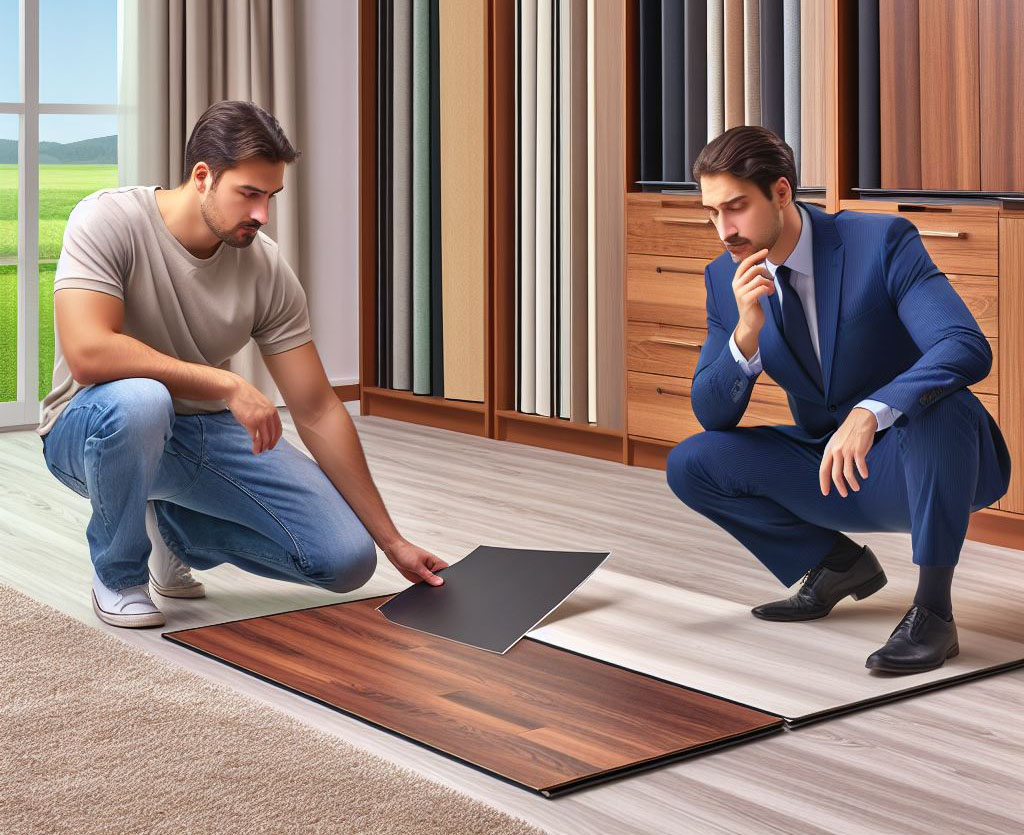In the dynamic world of home construction and renovation, vinyl and laminate flooring have emerged as prime choices for both professionals and DIY enthusiasts. These materials are not just alternatives to traditional hardwood or stone, they stand on their own merits, offering a blend of style, durability, and versatility.
This guide dives deep into the world of vinyl and laminate flooring. It’s tailored to provide insights for anyone from weekend DIYers to professional builders, helping you make informed decisions for your next flooring project.

Understanding Vinyl and Laminate Flooring
Vinyl Flooring: The Durable Chameleon
Vinyl flooring, a versatile option in the flooring market, excels in mimicking the look of more expensive materials like hardwood and stone. What makes vinyl stand out is its layered composition: a sturdy backing, a high-definition photo layer, and a protective wear layer that guards against scuffs and stains. This structure not only makes vinyl durable but also gives it a resilience that’s particularly useful in moisture-prone areas like kitchens and bathrooms.
Laminate Flooring: The Strong Imitator
Laminate flooring, akin to vinyl, is composed of multiple layers. It has a durable backing layer, a dense core board, a decorative photographic layer, and a clear wear layer on top. Although laminate may not match vinyl in moisture resistance, its strength against scratches and dents makes it a strong contender, especially in high-traffic areas.
Historical Context and Evolution
Vinyl and laminate flooring have evolved significantly since their inception. Vinyl first appeared in the mid-20th century and became a hallmark of modernity in post-war America. Laminate flooring, introduced later, offered an affordable yet appealing alternative to traditional hardwood. Over the years, both materials have shed their reputation as ‘cheap’ alternatives and have become preferred choices in modern construction and renovation.

Aesthetic Appeal and Design Variability
A Palette of Colors and Patterns
The range of colors, patterns, and designs in vinyl and laminate flooring today is impressive. You can choose from deep mahogany tones, crisp ash looks, or rustic stone textures. These flooring options offer a versatility that can complement any interior theme.
Realistic Wood and Stone Finishes
Both vinyl and laminate flooring have advanced to a point where they can convincingly mimic natural materials. Thanks to high-definition printing and sophisticated embossing techniques, these floors not only look like real wood or stone but also feel and sound similar. This realism adds a touch of elegance and warmth to any space.
Keeping Up with Flooring Trends
Flooring trends reflect broader shifts in lifestyle and design preferences. Currently, there’s a trend towards natural, sustainable looks, such as reclaimed wood or stone patterns. Manufacturers of both vinyl and laminate flooring are responding to this shift by offering eco-friendly options and designs that align with these trends.

Durability and Longevity
Vinyl Flooring: A Durable Choice
Vinyl flooring is renowned for its robust wear layer. This protective layer, measured in mils (thousandths of an inch), is your floor’s shield against daily wear and tear. In layman’s terms, the thicker this layer, the more resistant your floor is to life’s little accidents – from scuffs to spills.
- Residential Grade: Generally comes with a 10-20 mil wear layer, making it a suitable option for areas with moderate foot traffic.
- Commercial Grade: Boasts a thicker wear layer of 20-40 mils, designed to withstand the hustle and bustle of heavy foot traffic.
One of vinyl’s greatest strengths is its resistance to moisture, making it an ideal choice for bathrooms or kitchens where spills are common.
Laminate Flooring: Wear-Resistant and Long-Lasting
Laminate flooring, on the other hand, is gauged by its AC rating (Abrasion Criteria), which ranges from AC1, suitable for moderate residential use, up to AC5, designed for heavy commercial traffic.
- AC3 Rated Laminate: Perfect for all residential areas, robust enough to handle the energetic play of children and pets.
- AC4 and AC5 Ratings: These are better suited for high-traffic residential areas or commercial spaces.
However, laminate flooring is less forgiving when it comes to moisture. Prolonged exposure to water can lead to swelling or warping, so it’s not recommended for damp-prone areas.
Installation Ease and Flexibility
Vinyl Flooring: A DIY-Friendly Option
Vinyl flooring is often favored by DIY enthusiasts due to its straightforward installation process. Most vinyl flooring comes in either planks or tiles with a simple click-lock system.
- Floating Vinyl Planks: These are designed to snap together and float above your existing floor. Just ensure that your subfloor is even and debris-free.
- Peel-and-Stick Tiles: Ideal for a quick update. Simply peel off the backing and stick them down.
The adaptability of vinyl allows for installation over various surfaces, including concrete, plywood, or existing flooring.
Laminate Flooring: Easy and Efficient Installation
Laminate flooring is similarly user-friendly, especially for those who enjoy a bit of DIY. It typically employs a click-lock mechanism that allows the planks to seamlessly snap together.
- Installation Steps: Begin in a corner, lay down the underlayment for moisture protection, and then start piecing the planks together.
- Trimming: You’ll need a reliable saw to cut the planks for a proper fit, particularly around room edges and corners.
Laminate requires a flat and level subfloor to prevent any potential movement or flexing after installation.
Maintenance and Care
Vinyl Flooring: Effortless Upkeep
Maintaining vinyl flooring is relatively simple. Regular sweeping or vacuuming can keep it free from dirt and debris. For a more thorough clean, a damp mop will suffice – just avoid using abrasive cleaners that could scratch the surface.
Laminate Flooring: Careful Cleaning
Laminate flooring demands a bit more attention. It’s important to use only a damp mop for cleaning and to promptly clean up any spills to prevent water damage. Abrasive cleaners should be avoided to maintain the integrity of the surface.
Comparing Long-Term Maintenance:
- Vinyl Flooring: With proper care, vinyl can last between 10 to 20 years. It’s notably resilient against moisture and easy to clean.
- Laminate Flooring: Also has a lifespan of 10 to 20 years. While it can withstand heavy foot traffic, it requires careful maintenance to avoid damage from moisture.
Both flooring options provide considerable durability and longevity. Vinyl is the preferable choice for areas prone to moisture, while laminate is ideal for dry, high-traffic areas. With the right care, both can be a long-lasting addition to your home.
Cost Comparison
In the realm of flooring, the question of cost is as crucial as the material itself. Let’s dissect the financials, shall we?
Vinyl vs. Laminate: Breaking Down the Costs
- Vinyl Flooring: The price range here swings from $2 to $12 per square foot. Keep in mind, the top-tier luxury vinyl can notch up the price.
- Laminate Flooring: Generally more budget-friendly, laminate runs between $1 and $11 per square foot.
Weighing Long-Term Value
- Vinyl: You might fork out more initially, but vinyl’s resilience, especially in damp areas, often translates to less frequent replacements.
- Laminate: More economical at the outset, but its vulnerability to moisture might mean shelling out more in the long haul for repairs or replacements.
Environmental Impact and Health Considerations
Assessing the Environmental Impact
- Vinyl Flooring: The production and disposal of vinyl, often non-biodegradable, can be a bit of a black mark on the environment.
- Laminate Flooring: A somewhat greener option, laminate is predominantly made from wood byproducts. But, the use of certain adhesives and finishes does pose some environmental concerns.
Indoor Air Quality: A Crucial Factor
Both vinyl and laminate have been culprits in emitting volatile organic compounds (VOCs). However, the industry is shifting, with many manufacturers now offering low-VOC variants to safeguard indoor air quality.
Pros and Cons Summary
- Vinyl Flooring:
- Pros: Excellent water resistance, robust durability, diverse design options.
- Cons: Higher initial cost, environmental impact considerations.
- Laminate Flooring:
- Pros: More cost-effective, ideal for high-traffic areas, somewhat eco-friendlier.
- Cons: Poor resistance to moisture, potential VOC emissions.
FAQ Section
In the battle against moisture, vinyl unequivocally wins. It’s a reliable option for damp-prone areas, unlike laminate, which can suffer in soggy conditions.
Both are sturdy contenders, but laminate’s tough top layer slightly edges it ahead for high-traffic scenarios.
Yes, they can. Both types are adaptable to various subfloors. Just ensure the foundation is level and firm to avoid complications later on.
Indeed, they are. Both fare well, but vinyl’s superior scratch resistance makes it a marginally better option for pet owners.
Both, when chosen wisely and maintained well, can boost your home’s resale value. They add a modern touch and can be a selling point if they complement the house’s overall style.
